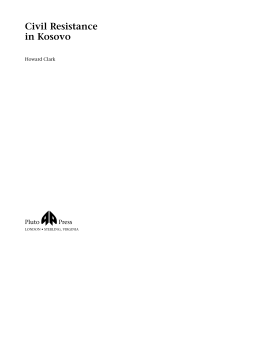
Additional Information
Book Details
Abstract
The world woke up to the conflict between Serbs and Kosovo Albanians too late – when Kosovo erupted into full-scale war in the spring of 1999. But many Balkans watchers were surprised war in Kosovo did not happen sooner. In Civil Resistance in Kosovo, Howard Clark argues that war had been avoided previously because of the self-restraint exercised by the Kosovo Albanians and their policy of nonviolence.
Prior to the Kosovo Liberation Army (KLA)'s taking up of arms, Kosovo Albanians had had a long history of civil resistance in the face of Serbian ultra-nationalism. They were committed to a strategy of nonviolent resistance even as they were harassed by Serbian police, vilified in racial terms, and excluded from jobs, education and government benefits. Excluded from the 1995 Dayton Agreement, Kosovo became a breeding ground for frustration and ethnic strife, ultimately leading to war and the NATO bombings.
The author traces the historical evolution of the Kosovo Albanians' struggle, from peaceful demonstrations to the KLA backlash, covering the 1980s to the present day. In assessing the achievements and limitations of nonviolence, Clark explains why the policy was ultimately abandoned and how it could have been made more effective. Importantly, this book draws on the lessons of Kosovo to provide suggestions for future peace-building.
Table of Contents
| Section Title | Page | Action | Price |
|---|---|---|---|
| Contents | iv | ||
| Acknowledgements | x | ||
| Maps | xii | ||
| Acronyms and Abbreviations | xiv | ||
| Brief Chronology | xv | ||
| Background on Kosovo | xix | ||
| Introduction | 1 | ||
| 1 When a dam breaks | 7 | ||
| The demographic battlefield: 1912-66 | 8 | ||
| After the fall of Rankovic ´ | 12 | ||
| The rising swell of nationalism | 15 | ||
| Milosevic mobilises | 18 | ||
| Lazar's curse: Whoever does not fight at Kosovo | 20 | ||
| 2 The Albanians in Kosovo | 24 | ||
| The Ottoman Empire | 24 | ||
| The First World War and the First Yugoslavia | 26 | ||
| The Second World War | 29 | ||
| A resistant culture | 31 | ||
| Tito s Yugoslavia | 37 | ||
| Everything but a republic | 39 | ||
| 1981 and afterwards | 41 | ||
| 3 The turn to nonviolence | 46 | ||
| Miners defend autonomy | 46 | ||
| An afterword on Communism in Kosovo | 45 | ||
| The Party crumbles | 52 | ||
| Organisation and pluralism | 54 | ||
| The Campaign to Reconcile Blood Feuds | 60 | ||
| Military realism | 64 | ||
| Nonviolence in Kosovo Albanian identity | 66 | ||
| 4 Two sovereignties | 70 | ||
| A Serbian recipe for Albanian separatism | 71 | ||
| Wholesale dismissals | 74 | ||
| 5 Parallel structures | 95 | ||
| Schools in struggle 96Open but illegal | 99 | ||
| The University of Prishtina | 100 | ||
| Funding education | 102 | ||
| The lesson taught | 104 | ||
| Medical care 106The media | 108 | ||
| Arts and sport | 111 | ||
| Economic survival | 112 | ||
| Politics as if | 115 | ||
| A state- in- embryo | 117 | ||
| 6 Pointers for an alternative strategy | 122 | ||
| The Dayton effect | 122 | ||
| A framework for active nonviolence | 128 | ||
| A strategy of empowerment | 131 | ||
| Altering Serbian will | 138 | ||
| Empowerment: women | 145 | ||
| Empowerment: youth | 149 | ||
| The student movement of 1997 98 | 151 | ||
| 7 When the world takes notice | 158 | ||
| Principles and interests | 158 | ||
| In the absence of a peace process | 163 | ||
| International solidarity takes time | 168 | ||
| International support for peacebuilding | 169 | ||
| The crisis erupts | 172 | ||
| OSCE too little, , too late | 178 | ||
| NATO bombs for credibility | 181 | ||
| 8 Reflections on civil resistance | 186 | ||
| The balance sheet on civil resistance | 189 | ||
| Victim behaviour and nonviolence | 193 | ||
| Leader syndromes | 198 | ||
| Goals and transitions | 203 | ||
| Civil resistance and conflict resolution 206Early warning, civil resistance and small nations | 210 | ||
| Appendix I: Tables | 215 | ||
| Appendix II: Notes on Terms, Pronunciation and Glossary | 217 | ||
| Appendix III: Leading Characters | 220 | ||
| Notes and References | 223 | ||
| Introduction | 223 | ||
| Chapter 1 | 223 | ||
| Chapter 2 | 228 | ||
| Chapter 3 | 232 | ||
| Chapter 4 | 235 | ||
| Chapter 5 | 239 | ||
| Chapter 6 | 243 | ||
| Chapter 7 | 248 | ||
| Chapter 8 | 252 | ||
| Select Bibliography | 258 | ||
| Index | 262 | ||
| Ackerman,Peter and Christopher Kruegler | 191 |
